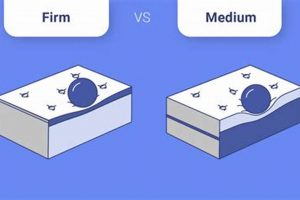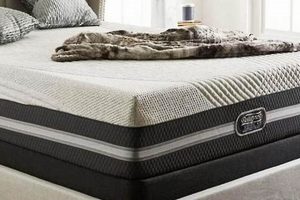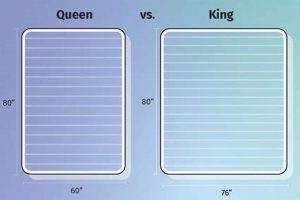The comparative analysis between a queen size sleeping surface and a king size sleeping surface focuses on dimensional differences, intended room size, and individual or partnered sleeping preferences. For example, a standard queen size offering typically measures 60 inches wide by 80 inches long, while a standard king size offering measures 76 inches wide by 80 inches long. These dimensional variances impact suitability for different bedroom spaces and comfort levels for sleepers.
The importance of this comparison lies in optimizing sleep quality and maximizing bedroom functionality. Selecting the appropriately sized sleeping surface contributes to improved rest, reduces sleep disturbances, and enhances overall well-being. Historically, mattress sizes evolved alongside changes in housing standards and a growing awareness of the relationship between sleep environment and health.
The subsequent discussion will delve into specific factors such as cost considerations, room size requirements, and the suitability of each option for single sleepers versus couples, thereby providing a comprehensive understanding to inform the selection process.
Key Considerations
The following are crucial points to assess when deciding between a queen size sleeping surface and a king size sleeping surface, ensuring the selection aligns with individual requirements and spatial limitations.
Tip 1: Evaluate Bedroom Dimensions: Prioritize measuring the intended bedroom space. A king size option requires a larger room to avoid feeling cramped and hindering movement. Queen size offerings are generally more adaptable to smaller spaces.
Tip 2: Assess Sleeping Partner Preferences: Consider the sleeping habits of all occupants. If one or both individuals tend to spread out during sleep, a king size option provides greater personal space, minimizing sleep disturbances.
Tip 3: Analyze Budgetary Constraints: Recognize that king size options generally incur higher costs than queen size options, not only in initial purchase price but also in associated bedding and accessories.
Tip 4: Determine Accessibility and Maneuverability: Factor in the ease of transporting the sleeping surface into the bedroom. Larger king size mattresses can present challenges navigating hallways and doorways.
Tip 5: Account for Frame and Bedding Availability: Ensure that a wide selection of frames and bedding is readily available in the desired size. While both sizes are common, specific styles or materials might be more limited in one versus the other.
Tip 6: Consider Future Needs: Project any potential changes in living arrangements or family size. A larger sleeping surface might be more advantageous in the long term if additional occupants are anticipated.
Tip 7: Prioritize Trial Periods and Return Policies: Take advantage of trial periods offered by retailers to assess comfort and suitability. A generous return policy provides recourse if the selected size proves unsatisfactory.
Careful consideration of these factors will facilitate a more informed decision, maximizing sleep quality and optimizing the utilization of available space. The subsequent sections will explore further aspects of mattress selection, including material composition and construction techniques.
1. Bedroom Size
Bedroom size is a primary determinant in selecting between a queen-size or king-size sleeping surface. The dimensions of the room directly influence the suitability and practicality of each option. A king-size mattress, being wider and potentially longer than a queen, demands a larger room to ensure adequate space for movement and other furniture. Conversely, attempting to accommodate a king-size in a smaller room can lead to overcrowding, hindering functionality and impacting the overall aesthetic. For example, a master bedroom measuring 12 feet by 12 feet might comfortably accommodate a queen, leaving sufficient space for dressers and walkways. However, placing a king in the same room could result in limited mobility and a visually cramped environment.
The correlation between bedroom size and mattress size extends beyond mere spatial constraints. It directly impacts the comfort and usability of the room. Overcrowding can lead to a sense of claustrophobia and impede daily activities. Furthermore, an undersized room for a king-size mattress may limit the placement of essential bedroom furniture, impacting storage and organization. Selecting the appropriate mattress size based on room dimensions, therefore, becomes a crucial aspect of interior design and spatial planning, affecting the overall living experience. Consider a scenario where a couple prioritizes the extra sleeping space of a king-size bed despite having a smaller bedroom. They might then need to compromise on other furniture pieces, such as bedside tables or a reading chair, to maintain some level of functionality.
In conclusion, the interplay between bedroom size and mattress selection is a key factor in determining the optimal sleeping arrangement. Careful measurement and consideration of spatial dynamics are essential to avoid compromising room functionality and comfort. The decision should reflect a balance between the desired sleeping space and the practical limitations imposed by the bedroom’s dimensions, thereby ensuring both aesthetic appeal and optimal usability. Choosing a queen-size or king-size is often a matter of understanding one’s unique sleep requirements within a set, physical location.
2. Sleeping Space
Sleeping space, defined as the surface area available to each sleeper on a mattress, is a critical determinant in the comparative analysis between a queen size and a king size mattress. The adequacy of individual sleeping space directly affects sleep quality, partner disturbance, and overall comfort. The difference in dimensions between the two mattress sizes translates to tangible variances in the available personal area.
- Individual Width Allocation
A queen size mattress offers approximately 30 inches of width per sleeper when shared by two individuals. A king size mattress provides a substantially larger 38 inches per sleeper. This extra width on a king size allows for greater freedom of movement during sleep, reducing the likelihood of unintentional contact and subsequent sleep disruption. For example, individuals who toss and turn frequently during sleep will generally experience a more restful night on a king size mattress due to the increased individual space.
- Partner Disturbance Mitigation
Adequate sleeping space is instrumental in minimizing partner disturbance. With more room to move without encroaching on a partner’s area, movements are less likely to transfer across the mattress. This is especially relevant for couples with differing sleep schedules or those sensitive to movement during sleep. A couple, where one partner is an early riser, might benefit significantly from the increased space of a king, allowing the early riser to exit the bed with minimal disturbance to the sleeping partner.
- Accommodation of Children or Pets
For families who occasionally share their sleeping surface with children or pets, a king size mattress offers a notable advantage. The expanded dimensions comfortably accommodate additional occupants without significantly compromising the primary sleepers’ comfort. A queen size mattress, conversely, becomes significantly more crowded with the addition of even a small child or pet, potentially leading to a less restful experience for all involved.
- Impact on Perceived Comfort
The perception of comfort is directly linked to available sleeping space. A confined sleeping area can induce feelings of restriction and discomfort, particularly for individuals accustomed to more expansive sleeping arrangements. The additional space afforded by a king size mattress often contributes to a greater sense of relaxation and freedom, leading to improved sleep quality. Conversely, individuals who sleep primarily in a fixed position might find the extra width of a king size less impactful on their overall comfort level compared to a queen.
The preceding points highlight the multifaceted nature of sleeping space and its direct relevance to the choice between a queen size and king size mattress. The optimal selection hinges on individual preferences, sleeping habits, partner dynamics, and the potential for accommodating additional sleepers. A thorough evaluation of these factors will facilitate a more informed decision, ultimately leading to enhanced sleep quality and overall well-being.
3. Cost Differential
The cost differential between a queen size mattress and a king size mattress represents a significant consideration in the purchasing decision. The larger surface area of a king size mattress necessitates a greater quantity of raw materials during manufacturing, directly influencing its higher price point. This disparity extends beyond the initial purchase, affecting the cost of associated bedding, frames, and potentially, increased shipping fees due to the greater size and weight. For example, a memory foam mattress in a queen size might be priced at $800, while a comparable model in king size could easily exceed $1200, representing a 50% increase. The initial investment is therefore substantially higher, impacting overall budget allocation.
The practical significance of understanding this cost differential lies in making informed financial decisions aligned with individual needs and resources. A king size mattress, while offering increased sleeping space, might not be justifiable for individuals or couples on a limited budget, especially if the benefits of the larger size do not outweigh the financial strain. Moreover, the ongoing costs associated with a king size mattress, such as specialized sheets and larger blankets, contribute to a sustained financial commitment. Conversely, for those prioritizing sleep quality and spaciousness, the higher upfront cost might be a worthwhile investment, particularly if viewed as a long-term asset impacting daily well-being. Furthermore, sales events or promotional periods might mitigate the cost difference, influencing the optimal time for purchase.
In summary, the cost differential is a critical component of the queen size mattress versus king size mattress comparison, affecting both initial and long-term expenses. Factors such as budget constraints, perceived value, and the availability of discounts should be carefully weighed to ensure a financially sound and strategically beneficial purchase decision. Neglecting this financial aspect can lead to buyer’s remorse or the acquisition of a sleeping surface that does not align with long-term budgetary considerations, thereby underscoring the importance of informed financial planning.
4. Partner Disturbance
Partner disturbance during sleep, a common concern for co-sleeping individuals, is significantly influenced by the choice between a queen-size and a king-size sleeping surface. The available space per sleeper, motion isolation capabilities of the mattress, and individual sleep habits all contribute to the potential for disruption, making mattress selection a crucial factor in minimizing sleep disturbances.
- Motion Transfer Mitigation
One key advantage of a king-size mattress in reducing partner disturbance lies in its larger surface area, which inherently mitigates motion transfer. When one partner moves, the vibrations are less likely to affect the other, compared to a queen-size where movement is more readily transmitted. Consider a scenario where one partner frequently gets up during the night; the likelihood of disturbing their co-sleeper is markedly reduced on a king-size mattress due to the increased distance and dampened motion.
- Personal Space Allocation
A king-size mattress provides significantly more personal space per sleeper than a queen-size. This increased space allows individuals to move more freely during sleep without encroaching on their partner’s area. Individuals who tend to spread out during sleep, or those who have differing sleep schedules, find this additional personal space particularly beneficial. For instance, a couple with disparate bedtime routines can enjoy separate, undisturbed sleep zones on a king-size mattress.
- Mattress Material Composition
The material composition of the mattress plays a crucial role in isolating motion and minimizing partner disturbance. Memory foam and certain types of innerspring mattresses are designed to absorb movement, preventing it from spreading across the sleeping surface. Selecting a mattress with enhanced motion isolation capabilities, regardless of size, can contribute to a more peaceful sleep environment. A memory foam mattress topper on either a queen or king can further dampen motion transfer.
- Weight Distribution and Support
Proper weight distribution and support are essential for reducing partner disturbance. A mattress with adequate support prevents excessive sinking or sagging, which can amplify motion transfer. A mattress that maintains a consistent surface level across its entirety minimizes the impact of one partner’s movements on the other. A hybrid mattress, combining innerspring support with memory foam comfort layers, often strikes a balance between support and motion isolation.
Ultimately, mitigating partner disturbance involves a multifaceted approach, where mattress size (queen versus king) intersects with material selection and individual sleep dynamics. While a king-size mattress provides an inherent advantage in terms of available space, the specific features and construction of the chosen mattress significantly influence the extent to which disturbances are minimized. Careful consideration of these factors enables couples to create a more restful and harmonious sleep environment.
5. Bedding Options
The selection of bedding options is intrinsically linked to the decision between a queen size mattress and a king size mattress. The dimensional differences between these mattress sizes directly dictate the size and type of bedding required, impacting cost, availability, and overall aesthetic. For instance, queen size mattresses require queen size sheets, comforters, and blankets, while king size mattresses necessitate correspondingly larger bedding sets. This fundamental relationship underscores the importance of considering bedding options as an integral component of the mattress selection process, rather than an afterthought.
The availability and variety of bedding options differ significantly between queen and king sizes. While both sizes generally offer a wide selection of materials, patterns, and thread counts, certain specialized or high-end bedding might be more readily available in one size compared to the other. Furthermore, the cost of bedding is directly proportional to its size. King size bedding, due to its greater fabric requirements, typically commands a higher price than queen size bedding, influencing the total cost of ownership for a given sleep setup. A practical example involves a couple who initially chose a king size mattress for its spaciousness but later found that their preferred linen material was significantly more expensive and less readily available in king size, ultimately impacting their satisfaction.
In summary, the connection between bedding options and mattress size is a critical consideration often overlooked in the queen size mattress versus king size mattress decision. The size of the mattress directly dictates the dimensions and cost of subsequent bedding purchases, while availability and variety can influence aesthetic and material preferences. Understanding this relationship enables a more holistic and informed decision, ensuring that the chosen mattress not only provides optimal comfort but also aligns with budgetary constraints and desired aesthetic outcomes.
6. Transport Feasibility
Transport feasibility constitutes a critical logistical consideration in the selection process between a queen size mattress and a king size mattress. The significantly larger dimensions and increased weight of a king size mattress present distinct challenges during relocation and initial delivery, impacting both cost and logistical planning. Evaluating transport feasibility prevents potential complications associated with maneuvering bulky items through confined spaces.
- Doorway and Hallway Dimensions
The dimensions of doorways, hallways, and stairwells within a residence directly influence the transport feasibility of a mattress. A king size mattress, due to its substantial width, may not easily pass through standard doorways or navigate narrow hallways, necessitating alternative entry methods or, in extreme cases, rendering it impossible to install without structural modifications. Conversely, a queen size mattress, with its comparatively smaller footprint, is generally more manageable within standard residential layouts. Consider a scenario where a homeowner purchasing a king size mattress discovers, upon delivery, that it cannot be maneuvered past a narrow stairwell, requiring the engagement of specialized moving services or, ultimately, a return of the item.
- Vehicle Capacity and Type
The capacity and type of vehicle required for mattress transport are directly correlated to its size and weight. Transporting a king size mattress typically necessitates a larger vehicle, such as a moving truck or a full-size pickup truck, potentially incurring rental or transportation fees. A queen size mattress, in contrast, may be accommodated within a smaller vehicle, such as a minivan or SUV, reducing transportation costs and logistical complexities. Individuals opting for self-transport of their mattress must assess the vehicle’s cargo capacity and weight limitations to ensure safe and compliant transport. Failure to adequately secure a large mattress during transport can pose significant safety hazards.
- Elevator Constraints in Multi-Story Buildings
In multi-story residential buildings equipped with elevators, the dimensions and weight capacity of the elevator car are critical determinants of transport feasibility. A king size mattress may exceed the dimensions or weight limitations of certain elevators, necessitating manual transport via stairwells, which can be physically demanding and potentially damaging to both the mattress and the building’s infrastructure. Queen size mattresses, being smaller and lighter, are generally more easily accommodated within elevator constraints. Building management often imposes restrictions on the transport of large items, requiring prior notification and adherence to specific guidelines.
- Delivery Service Limitations and Costs
Utilizing professional delivery services for mattress transport introduces additional considerations related to service limitations and associated costs. Some delivery services may impose surcharges or refuse to deliver oversized items to locations with limited accessibility, such as those involving steep inclines, narrow passages, or multiple flights of stairs. The cost of delivery typically increases with the size and weight of the item, making king size mattress deliveries more expensive than queen size deliveries. Furthermore, scheduling and coordination with delivery services require advance planning to ensure that the mattress can be delivered during designated time windows and to an accessible location.
These facets underscore the pragmatic importance of assessing transport feasibility during the mattress selection process. The decision between a queen size and a king size mattress must account for not only sleeping preferences but also the logistical realities of delivery and installation within a specific residential context. Overlooking these considerations can lead to unforeseen complications, increased costs, and potential damage to property or personal injury. Therefore, a thorough evaluation of access routes, vehicle capacity, and delivery service limitations is essential for a seamless and cost-effective mattress acquisition.
7. Long-Term Needs
The consideration of long-term needs is paramount when deciding between a queen size mattress and a king size mattress. These needs encompass potential changes in living arrangements, family size, health conditions, and financial stability, each influencing the optimal mattress selection for sustained comfort and practicality over an extended period.
- Evolving Relationship Dynamics
Relationship dynamics are subject to change over time. A couple may initially require a queen size mattress, but anticipate future needs for greater personal space, potentially driven by differing sleep schedules or increased sensitivity to movement. A king size mattress may then represent a more prudent long-term investment, mitigating potential sleep disturbances and enhancing overall relationship harmony. Conversely, separation or a shift to single occupancy negates the need for a larger sleeping surface, rendering a queen size a more suitable option. The anticipation of such changes warrants careful consideration when evaluating mattress size.
- Changes in Family Composition
The prospect of expanding family size, either through childbirth or adoption, directly influences long-term sleeping arrangements. A couple planning to have children may find that a king size mattress offers the necessary space to comfortably accommodate infants or young children during occasional co-sleeping situations, such as illness or parental reassurance. As children grow older, the need for a larger sleeping surface diminishes, potentially shifting the preference back to a queen size for the primary occupants. These anticipated shifts in family structure demand a forward-thinking approach to mattress selection, balancing current needs with future possibilities.
- Potential Health Considerations
The emergence or progression of certain health conditions can significantly impact sleep requirements and preferences. Individuals with chronic back pain or mobility limitations may benefit from the increased space and customizable adjustability offered by a king size mattress, facilitating easier repositioning and reducing discomfort during sleep. Conversely, those with allergies or sensitivities to specific mattress materials may prioritize hypoallergenic or organic options, regardless of size, focusing on health-related factors over dimensional considerations. Anticipating potential health challenges and their impact on sleep patterns is crucial for making informed mattress selections that promote long-term well-being.
- Financial Fluctuations and Investment Horizon
Financial stability and long-term investment horizons play a significant role in mattress selection. While a king size mattress typically represents a higher initial investment, its potential for extended use and adaptability to changing needs may justify the increased cost over time. Conversely, individuals with limited financial resources or uncertain economic outlooks may opt for a more affordable queen size mattress, prioritizing short-term affordability over long-term adaptability. Considering financial fluctuations and the anticipated lifespan of the mattress is essential for making fiscally responsible decisions that align with individual economic circumstances.
In conclusion, the decision between a queen size mattress and a king size mattress must extend beyond immediate needs, encompassing a comprehensive assessment of potential long-term changes. Factors such as evolving relationship dynamics, family composition, health considerations, and financial stability each contribute to the optimal mattress selection for sustained comfort, practicality, and financial prudence over an extended period. A forward-thinking approach that anticipates future needs ensures that the chosen mattress continues to provide optimal sleep support and meet evolving lifestyle requirements.
Frequently Asked Questions
The following addresses common inquiries regarding the choice between queen size and king size sleeping surfaces, offering clarity on key considerations for informed decision-making.
Question 1: Is a king size always the superior choice for couples?
Not necessarily. While a king size provides more individual sleeping space, bedroom dimensions and budgetary constraints should be considered. A queen size may be adequate if space is limited or costs are a primary concern. Superiority is determined by individual needs and circumstances.
Question 2: Does mattress type impact the size selection decision?
Yes. Certain mattress types, such as memory foam, may exhibit greater motion isolation. This characteristic can mitigate the need for a larger king size if partner disturbance is a primary concern, potentially making a queen size a viable option. The interaction between mattress construction and size should be evaluated.
Question 3: Are there specific room size recommendations for each mattress size?
Generally, a minimum room size of 10 feet by 10 feet is recommended for a queen size mattress, while a king size typically requires a room of at least 12 feet by 12 feet. These are guidelines; actual space requirements depend on additional furniture and desired mobility.
Question 4: How does the cost of bedding factor into the overall comparison?
King size bedding generally commands a higher price than queen size bedding due to the increased fabric requirements. This cost difference should be factored into the overall budget when assessing the affordability of each option.
Question 5: What are the implications for resale value of each mattress size?
Both queen and king size mattresses maintain reasonable resale value, with queen size models potentially appealing to a broader market due to their greater adaptability to smaller spaces. However, resale value is also influenced by mattress condition, brand, and age.
Question 6: Is there a significant difference in weight between the two sizes?
Yes. King size mattresses typically weigh significantly more than queen size models, posing challenges during transport and setup. This difference in weight should be considered, especially for individuals living alone or in multi-story buildings without elevator access.
In summary, selecting between a queen size and a king size mattress requires a comprehensive evaluation of space, budget, sleeping preferences, and logistical considerations. No single answer applies universally; individual circumstances dictate the optimal choice.
The subsequent discussion will explore specific mattress materials and their influence on sleep quality and overall comfort.
Conclusion
This exploration of “queen size mattress vs king” has highlighted critical distinctions. The dimensional variances, budgetary implications, and logistical considerations necessitate a comprehensive assessment. Bedroom size, sleeping partner preferences, and long-term needs must be carefully weighed to determine the optimal choice.
The selection of a sleeping surface is a consequential decision impacting health and well-being. Further research into specific mattress types and materials is encouraged to ensure a sound and beneficial investment in quality sleep. The decision between a queen size mattress versus a king should be based on a rigorous and personal evaluation of all aspects.







